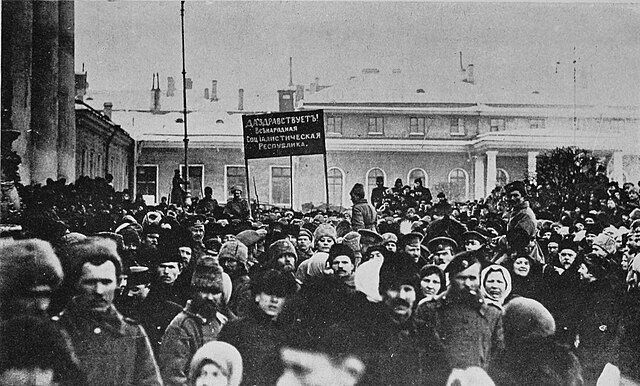first of two revolutions in Russia in 1917 From Wikipedia, the free encyclopedia
The February Revolution of 1917 was a revolution that ended the monarchy in the Russian Empire. A provisional government replaced the Tsar, Nicholas II. This was the beginning of the Russian Revolution. The February Revolution was caused by problems of World War I. These included economic and other hardships.
An expert on the subject should have a look at this article or section. This is because it lacks basic details (December 2023) |
This article does not have any sources. (June 2023) |

Industrialization had already spread from Petrograd (now Saint Petersburg) and other cities. When Russia lost the Crimean War to England and France in 1856, it was obvious that Russia needed economic and social change to keep up with other countries. Large reforms followed, including the abolition of serfdom in 1861, judicial reform in 1864, and the establishment of national government groups, called Semstwos, in 1864. This was designed to encourage industrial growth.
Russia had an economic crisis during the Crimean War. The country did not have enough new weapons or new machines. After the war, the Tsar, Russia's emperor, tried to change this. He increased Russia's ability to make things in factories. This cost the Russian people a lot of money.
Most of the economic, social, and cultural change was in cities. To get ready to develop more modern industry, new laws were made to increase the power of regional leaders. Cultural modernization included development of new styles in literature and art. A new group of people who focused on art and literature sought further reforms.
The Russian national economy was still mostly based on farming and most people were peasants. Because the number of people grew faster than the ability to grow food, there were serious food shortages. Agrarian social protest was usually spontaneous but did not last long. The farmers always went back to their farms. This happened in the hot autumn of the year 1905, and again in the late summer of 1917. Rural areas remained calm after World War I began in 1914. Because most of the soldiers came from villages, few people were left to fight against the authorities.
The war brought Russia more than a million dead. The war had begun, as in all European states, with high national morale. However, defeat in the Gorlice–Tarnów Offensive in 1915 led to other defeats. The legitimacy of the autocratic Romanovs was weakened further by the fact that Nicholas II had personally taken command of the armed forces. Each further retreat and defeat damaged the reputation of the regime. The workers and farmers, like other Russians, were unhappy. They no longer supported the Tsar. In September 1915, the Tsar sent the parliament home. Tensions increased and endangered the internal peace of the realm.
Nicholas II did not get along well with the elected Duma. Nicholas II ignored the advice of his former Minister of Finance Sergei Juljewitsch Witte, who recommended comprehensive reforms. The frequent defeats combined with food shortages and the catastrophic supply situation to cause the revolution. The increasing anger of the population showed up in the Duma, which was dominated by representatives of the middle class and the aristocracy. In the Duma of 1915, the progressive block was the strongest parliamentary opposition.
In February 1917, army units stopped fighting revolutionaries in the capital and joined them instead. They took control of the capital and prevented the Tsar from returning. He eventually agreed to give up the throne.
Seamless Wikipedia browsing. On steroids.
Every time you click a link to Wikipedia, Wiktionary or Wikiquote in your browser's search results, it will show the modern Wikiwand interface.
Wikiwand extension is a five stars, simple, with minimum permission required to keep your browsing private, safe and transparent.